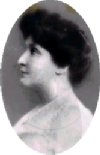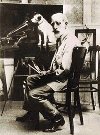 (29k)
(29k)
1902
- Dame Nellie Melba
When people wanted to listen to music one hundred years ago they had to either make it themselves or go to hear someone else play. The opportunity therefore to listen to music created by a large scale ensemble was restricted to those who could afford concert tickets. The notion of capturing sound and replaying it was regarded as eccentric.
The earliest attempts to prove that recording was possible occurred in 1877 when Thomas Edison invented his tin-foil Phonograph. The sound quality was atrocious and each recording had a life-time of one performance. Edison's work was built on by the Scots-born inventor of the telephone, Alexander Graham Bell, who invented a wax cylinder and a machine to play them - the graphophone. Unlike its tin-foil predecessor, the wax cylinder could be used repeatedly. The remaining drawback, however, was that they could not be duplicated. The musicians being recorded had to perform for each cylinder cut.
In 1887 German-born Emile Berliner succeeded where others had failed. In inventing a system of recording which could be used repeatedly and easily produced, he abandoned the cylinder in favour of a flat disc. The platter was born! Berliner patented a machine to play his discs, the gramophone, which became commercially viable when another inventor, Elridge Johnson, built a spring motor which would ensure that the turntable revolved at an even speed. This breakthrough encouraged Berliner to found The Gramophone Company to mass manufacture the discs and the machine that played them. One hundred years ago in 1897 he dispatched a representative to Britain to introduce the gramophone to Europe. Hot on his heels, however, was a representative of the Columbia Phonograph Company determined to steal a lead for its improved cylinder technology.
The technology was one thing, but persuading popular artists to stake their credibility on the new contraption was something else. The breakthrough in that area came in 1900 when Berliner's Gramophone Company succeeded in signing the Enrico 'the great' Caruso and Dame Nellie Melba.
 (29k)
(29k)
1902
- Dame Nellie Melba
The company's marketing strategy was boosted in 1908 with the adoption of Francis Barraud's painting of 'His Master's Voice' as its official trademark. The image of dog in question, 'Nipper', became a familiar sight up and down the country as by 1914 one in three British homes boasted one of Mr. Berliner's gramophones.
 (36k)
(36k)
1899
- Barraud with his famous painting
music 100 recalls those pioneering days through the sheet music, musical instruments and music boxes of the days before recorded sound. It will also display the earliest tin-foil phonograph, the Columbia Company's wax cylinder graphophone and the first Berliner gramophone. In addition the exhibition includes pictures of Emile Berliner at work, correspondence concerning his new invention and the contracts of the first musical stars to sign with a record company.